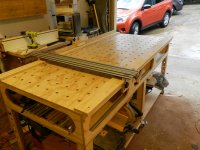Corwin
Member
- Joined
- Jan 22, 2007
- Messages
- 2,624
Klemm said:INCRA parts for home made parallel guide was a creative approach. I'll have to look into INCRA further for special fixture building projects.
SketchUp ability to do animations was news to me. Because of the woodworker oriented set-up in this CAD application I am attracted to using it rather than my full blown SolidWorks. But even though it is intuitive in mmany ways I quickly discovered the learning curve is not a short one. Your reaction serves as a further caution against an unplanned diversion of time into SketchUp when I really want to get going with several woodworking projects including the construction of a full set of wood biplane wings.
I am trying to figure out if there is a relatively simple way to arrive a functionality like the flip-up track hinge on the MFT to get "squar" for crosscuts. I.m thinking I would not need 100 plus dog holes. Just six shoul suffice to get square. I'm anxious to try my hand and find out what I still need and need to learn or know. Your critical comments regarding the need for MFT hole pattern was helpful. I am thinking a Woodpecker square - is there any other Square more appropriate?
thanks again
Hans
Reading your reply, I feel I need to say that I didn't mean that SketchUp has a lengthy learning curve, but rather the process of creating an animation is what was taxing on my time. Sorry I wasn't more clear. Actually, I found SketchUp very quick to learn. And there are a ton of videos to answer most any question you have along the way. But, it is sometimes faster and easier to delete and redraw mistakes rather than correct them -- yet, the act of correcting things might just teach you more... [big grin]


